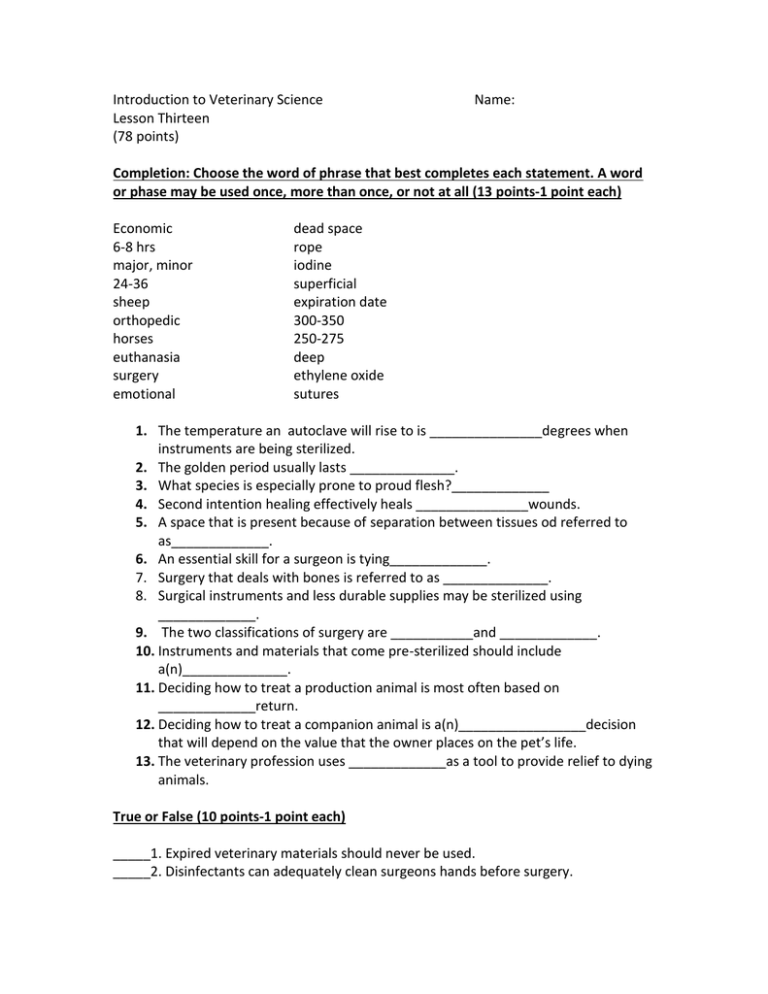File
advertisement

Introduction to Veterinary Science Lesson Thirteen (78 points) Name: Completion: Choose the word of phrase that best completes each statement. A word or phase may be used once, more than once, or not at all (13 points-1 point each) Economic 6-8 hrs major, minor 24-36 sheep orthopedic horses euthanasia surgery emotional dead space rope iodine superficial expiration date 300-350 250-275 deep ethylene oxide sutures 1. The temperature an autoclave will rise to is _______________degrees when instruments are being sterilized. 2. The golden period usually lasts ______________. 3. What species is especially prone to proud flesh?_____________ 4. Second intention healing effectively heals _______________wounds. 5. A space that is present because of separation between tissues od referred to as_____________. 6. An essential skill for a surgeon is tying_____________. 7. Surgery that deals with bones is referred to as ______________. 8. Surgical instruments and less durable supplies may be sterilized using _____________. 9. The two classifications of surgery are ___________and _____________. 10. Instruments and materials that come pre-sterilized should include a(n)______________. 11. Deciding how to treat a production animal is most often based on _____________return. 12. Deciding how to treat a companion animal is a(n)_________________decision that will depend on the value that the owner places on the pet’s life. 13. The veterinary profession uses _____________as a tool to provide relief to dying animals. True or False (10 points-1 point each) _____1. Expired veterinary materials should never be used. _____2. Disinfectants can adequately clean surgeons hands before surgery. _____3. During scrubbing for surgery, the surgeons hands should be held higher than the elbows. _____4. The third fluid accumulation is dead space is referred to as a hematoma. _____5. Non-absorbable suture material is used within the body. _____6. Spaying is one of the most commonly performed abdominal surgeries in pets. _____7. Sterilizing surgical equipment through autoclave is an extremely expensive procedure. _____8. Since both areas need to be sterile, there is no need to separate the surgery preparation areas from the actual surgery area. _____9. Monitoring the ability of the animal to maintain normal physiology, such as body temperature and fluid balance, is an important part of monitoring anesthetic recovery. _____10. It is not necessary to keep records of post-operative care of the animal once the surgery is done. Matching: Match the surgical instrument with the proper procedure.(10 points-1 point each) a. metzenbaum dissecting scissors b. spay hook c. scalpel d. hemostatic forceps e. curved scissors f. tissue forceps g. towel clamps h. needle holder i. retractor j. straight-blade scissors _____1. Holds tissue and exposes the surgical area _____2. Brings the uterus through a relatively small incision _____3. Holds the needle used during suturing _____4. Has various tips, used for handing tissue _____5. Used to cut delicate tissue _____6. Used to attach surgical drapes to the animal _____7. Makes the incision into the animal _____8. Used to clamp blood vessels _____9. More maneuverable cutting tool used during surgery _____10. Can cut through tougher tissue Definitions: Provide a complete definition for each term below (10 points- 1 point each) 1. aseptic technique2. disinfectants3. sterilation4. autocalve5. antiseptic6. dehiscence7. necrotic8. sternal position9. asepsis10. analgesiaDiscussion: Answer each of the following essay questions with at least one complete paragraph. (10 points- 2 points each) 1. Differentiate between major and minor surgery. 2. Why is it crucial to be aware of instrument and hand position at all times during surgery? 3. When is it acceptable to use a cold sterilant solution when disinfecting instruments? 4. List the three elements that are extremely important in achieving asepsis. 5. How can dead space be removed during closure? Essay: Answer the following questions in at least one complete paragraph(25 points- 5 points each) 1. Thoroughly describe how to monitor post-procedural complications. 2. Explain the proper techniques one must use when stitching sutures. 3. Summarize proper surgeon preparation techniques. 4. Explain the requirements for surgical procedure sites. 5. Discuss the role that the veterinarian plays in determining of a companion animal should be put to sleep.






